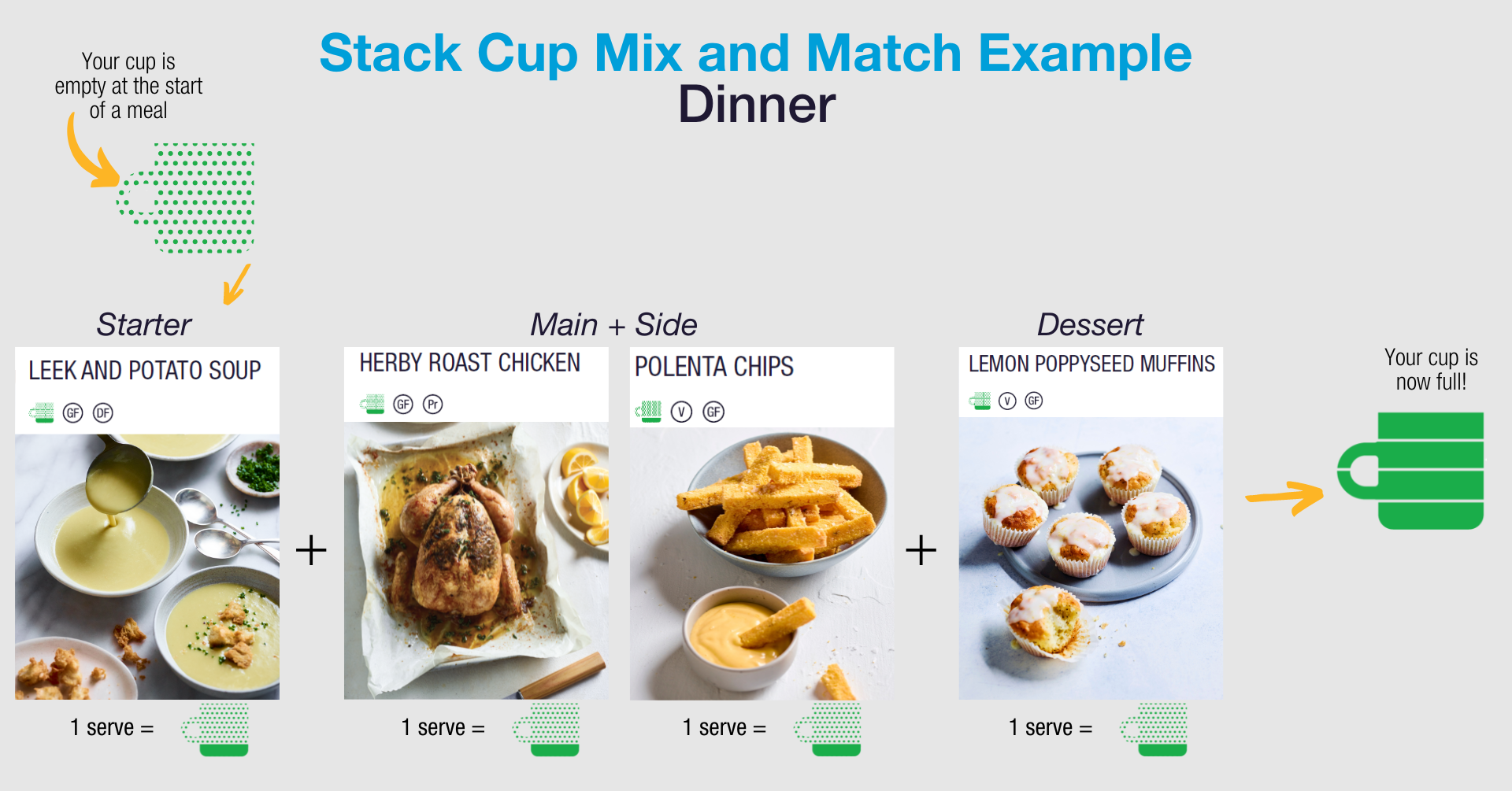
We have long recognised that single foods do not make a diet. People eat combinations of foods and whole meals and want to know that each recipe, and indeed each combination of recipes, is low in FODMAPs. To make this possible, our cookbook introduces the new Monash University Low FODMAP Stack Cup. Using this symbol, you can quickly and easily understand what you can eat in one sitting, allowing you to mix and match recipes to create delicious, low FODMAP meal plans without triggering IBS symptoms
Using the Monash University Low FODMAP Stack Cup, one full cup represents the upper limit of FODMAPs that most people will tolerate in one sitting. The Stack Cup symbol, which will be found alongside our recipes, is made up of bands which indicate the amount of FODMAPs provided in one serve of each dish, relative to the amount you should tolerate in one sitting.
We know that most people tolerate 0.5 grams of FODMAPs in one sitting[1]. Using our stacking symbol, each band represents 0.125 grams of FODMAPs (or ¼ of your FODMAP limit per meal). This means that you can include up to 4 bands per meal, before you ‘fill your cup’ and reach your 0.5 grams FODMAP limit for that meal. After 2–3 hours, we assume that the ‘cup’ returns to zero.

This cup will be found next to recipes that we have developed, to indicate the number of bands (representing the amount of FODMAPs) in each serving of that recipe. All of our recipes are low FODMAP on their own, but this symbol allows you to choose recipes that you can combine to keep your meal staying low FODMAP. See this example from our cookbook of how you will see the Stack Cup:


In the morning we start off with an empty cup. If we pair our green smoothie recipe (which has 3 bands) and a breakfast muffin serve (which is 1 band), this provides 4 bands giving us our full cup, which is likely the limit of FODMAPs that we would tolerate for this meal.
As this food moves through our gastrointestinal system to be digested, after 2-3 hours our Stack Cup resets back to empty.

For lunch, you might decide to have the Middle Eastern Fish with Tahini Sauce (this has 2 bands) with our Tabouli on the side (another 2 bands). This will make up the 4 bands to fill your cup back up again.
After another 2-3 hours, our Stack Cup again resets to 0 bands, leaving it empty.

Dinner may be your main meal of the day so you might enjoy a few courses. You could start with 1 serve of the Leek and Potato Soup (1 band), followed by a main of 1 serve of the Herby Roast Chicken (1 band) and 1 serve of the polenta chips (1 band) for the side. To finish it off with something sweet, you could have 1 serve of the Lemon and Poppyseed Muffins (1 band). This whole meal would provide 4 bands in total, meaning you have reached your FODMAP limit for that meal.
Whilst vegan and vegetarian diets can be difficult to navigate on the low FODMAP diet, with the aid of the Stack Cup you can combine some delicious flavours while still staying vegan and low FODMAP.

In this example, you could pair an Indian Channa Dahl (3 bands) with an Indian Potato Curry (1 band) which will fill the 4 bands of your Stack Cup whilst still being vegan and vegetarian.
It is important to note that you do not have to fill your Stack Cup every meal. This is merely a guide to the limit of FODMAPs most people will tolerate before getting symptoms. Some recipes can be made and enjoyed on their own that contain 1, 2, 3 or even no bands.
If you were to “overfill” your Stack Cup, you will potentially experience IBS symptoms as the meal is no longer low FODMAP. You may need to wait a bit longer before the next meal, and it may be best to make sure that it is safely low FODMAP. Everyone is different and it depends on what your trigger FODMAPs are, however, the Stack Cup cut-offs are quite conservative so most people will likely be fine with a little bit extra.
The Stack Cup resource will be slowly rolled out with our old recipes (both online and in our app) as well as being included in future recipes that we develop.
If you want to learn more about stacking outside of the Monash University Low FODMAP Stack Cup, we have our previous stacking blog that could help.
1. Halmos, E.P., et al., A diet low in FODMAPs reduces symptoms of irritable bowel syndrome. Gastroenterology, 2014. 146(1): p. 67-75 e5.